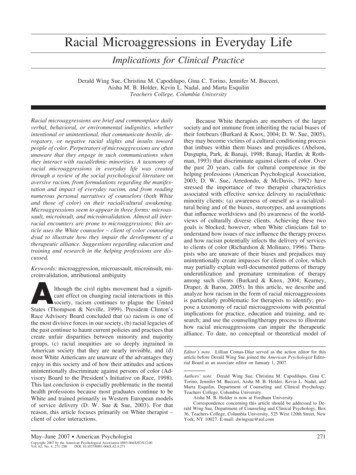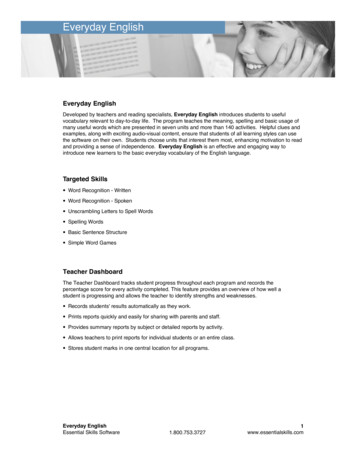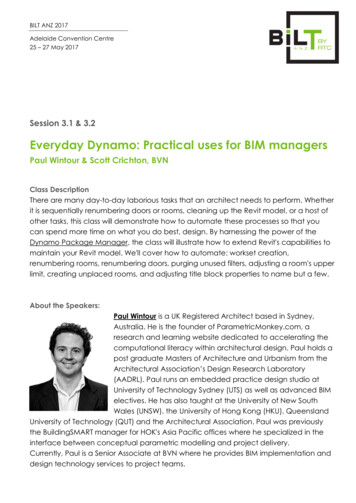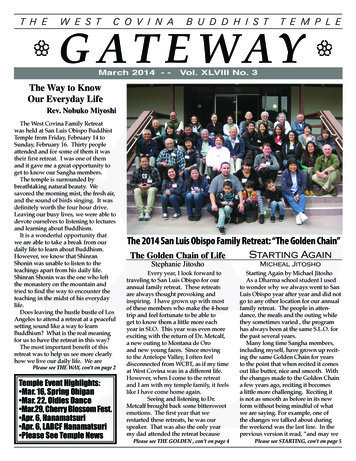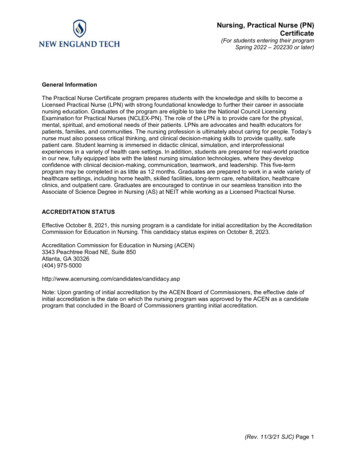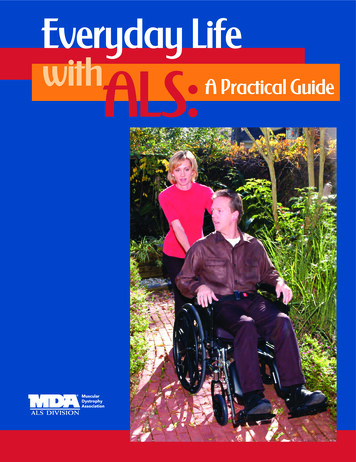
Transcription
Everyday LifewithA Practical GuideALS:
Everyday Life with ALS:A Practical GuidePublished and distributed by the MDA ALS DivisionMDA Publications Department 2005, 2010 Muscular Dystrophy Association Inc.Everyday Life with ALS: A Practical Guide3
Everyday Life with ALS: A Practical GuidePublished byMDA ALS Division3300 E. Sunrise DriveTucson, AZ 85718R. Rodney Howell, M.D., Chairman of the BoardGerald C. Weinberg, President & CEOals.mda.orgCopyright 2005, 2010 Muscular Dystrophy Association Inc.All rights reservedNo part of this book may be reproduced in any form or by anymeans without the prior written permission of the publisher,excepting brief quotes used in connection with reviews writtenspecifically for inclusion in a magazine or newspaper.Free to families of those with ALS who are registered withMDA. 15 for others and 20 for international orders (includesCanada). Contact publications@mdausa.org.4
ACKNOWLEDGMENTSThis book is a revision and expansion of ALS: Maintaining Mobility,A Guide to Physical Therapy andOccupational Therapy, which was published by the MDA/ALS Center at BaylorCollege of Medicine in Houston andMDA in the early 1980s. The authorswere the late Vicki Appel, R.N., ALSClinic Coordinator, along with MelindaCallendar, physical therapist, and SusanSunter, occupational therapist.Their pioneering work was an essential and solid foundation for the creationof this volume, and a significant numberof the original illustrations from thatbook are found here, and are reprintedwith permission.We’re especially indebted to the Deanaand Sheldon Katz Fund for an earlygrant that enabled MDA to inauguratethis project.The contents were carefully reviewedby a number of ALS experts. Primaryamong them were Valerie Cwik, M.D.,MDA’s Medical Director; Stanley Appel,M.D., director of the MDA/ALS Centerat Methodist Hospital in Houston anda member of MDA’s Board of Directors;and Peggy Ingels Allred, physical therapist, clinical evaluator, Department ofNeurology, Baylor College of Medicine,Houston.The input of several other professionalexperts who work with MDA/ALS centerswas also invaluable. We’re deeply grateful to: Jeff Edmiaston, M.S., CCC-SLP(speech-language pathologist), BarnesJewish Hospital Rehab Department,St. Louis; Lyn Goldsmith, R.N., B.S.N.,clinical research nurse/coordinator,Department of Neurology, Eleanor andLou Gehrig MDA/ALS Research Center,Columbia University Medical Center, NewYork; Jackie Montes, M.A., P.T., clinical coordinator and physical therapistat the Gehrig center at Columbia; JeroldE. Reynolds, Ph.D., registered respiratory therapist and respiratory care practitioner, associate professor of neurology, Ohio State University, Columbus;Jeanine Schierbecker, M.H.S., P.T.,Washington University School ofMedicine, Department of Neurology, St.Louis; Laurie Sterling, M.S., CCC-SLP,Baylor; and Marilyn Trial, OTR, Baylor.At MDA, special guidance was offeredby Senior Vice President of HealthCare Services Michelle Morgan; andALS Health Care Service CoordinatorsDebbie King in St. Louis; Kathy Petersin Shawnee Mission, Kan.; and AnneSwisher in Houston (thanks especiallyfor the help checklist in Chapter 2).We gratefully acknowledge Christopherand Reda Rice of Houston, 2004 and 2005co-chairs of MDA’s ALS Division, and PaulEveryday Life with ALS: A Practical Guide5
and Helen Magoon and Sandra Hansenof Tucson, Ariz., for posing for photos. Those photos were taken by BobbyBedient and James S. Wood.All of the chapter opening photographsand many others in this book featurepeople with ALS. Other photos depictpeople who have other neuromusculardiseases in MDA’s programs.Thanks also go to these companiesfor supplying photographs used here:Ableware by Maddak; Adrian’s Closet;Bruno; Diestco; Duralife; DynaVox;EZ Accessories; Forde’s FunctionalFashions; Grabit; InterAct; Invacare; J.H.Emerson; Kensington; Keybowl; LibertyMotors; Lubidet; Madentec; Magitek;No Boundaries/Tzora; Open Sesame;Permobil; Prairie View Industries;Premier Bathrooms; Prentke Romich;Quickie by Sunrise Medical; R.D.Equipment; Respironics; Rolli-Moden;SafeTek International; Spec-L; Supracor;SureHands Lift & Care Systems; TheEmergency Phone; TiLite; Touch Turner;United Security Products; and Völker.The MDA Publications Team6
ALS Division — MDAMDA is the world leader among voluntary agencies in fightingamyotrophic lateral sclerosis. Since the early 1950s,when Eleanor Gehrig served as MDA’s national campaign chairman,the Association has assisted those affected by the disordernamed for her husband, baseball great Lou Gehrig,who died of ALS in 1941 at the age of 37.MDA’s ALS Division offers the most comprehensive range of servicesof any voluntary health agency in the nation, and leads the search fortreatments and cures through its worldwide research program.For more about MDA’s ALS Division, see page 126 orvisit als.mda.org.Everyday Life with ALS: A Practical Guide7
Everyday LifewithA Practical oductionUsing the GuideSpotlight: What is ALS?Spotlight onYour Health Care Team12151416Equipment for Daily LivingWhat Kind of Equipment WillYou Need?The Role of theOccupational TherapistHelp with Activitiesof Daily LivingBedsAdaptable ClothingTelephone EquipmentBooksSpotlight on Clothing andDressing Hints8Table of Contents343637Home ModificationsArchitectural BarriersHome SafetyMaking Your Home MoreAccessibleSafety EquipmentBathroom ModificationsSpotlight on Bathroom Fixtures3839414344471819202426282827Saving EnergyBattling FatiguePrinciples of EnergyConservationEveryday ActivitiesPersonal CareSpotlight on Care CirclesSpotlight: Checklist forGetting Help303131Mobility & SupportEquipmentMaintaining IndependenceThe Role of the Physical TherapistLeg BracesHead and Neck SupportHand on IssuesSpotlight on Accessible Vans5051525354545556576265
ExerciseRespiratory IssuesHow Does ALS Affect Breathing?The Role of the RespiratoryTherapistAssisted VentilationTypes of Ventilation andEquipmentCoughing and ClearingSecretionsOther EquipmentMedicationsSpotlight on Feeding Tubes6869707173747575Speech & CommunicationHow Does ALS Affect Speech?The Role of the SpeechLanguage PathologistAssistive TechnologyAugmentative, AlternativeCommunication DevicesComputer AccessEnvironmental Control UnitsSpotlight on Finding Funding78798081838586TransfersMoving With HelpInstructions for CaregiversSpecial TransfersBody Mechanics for theCaregiverDependent TransfersMechanical and Hydraulic LiftsBed PositioningSpotlight on Transfer Tips &PrecautionsSpotlight on RecoveringFrom a FallWhy Is Exercise Important?98The Role of the PhysicalTherapist99Exercise Precautions100Staying Active100Stretching & Range-of-MotionExercises101Cardiovascular Conditioning 102Exercise Equipment105Strength Training106Alternative Exercises106Spotlight on Massage Therapy 104107Spotlight on ShouldersExercise InstructionsGuidelinesStretching ExercisesRange-of-Motion ExercisesSwimming & Water-BasedExerciseSpotlight on 9191939495MDA ALS DivisionGeneral ResourcesResources by Chapter126129131Index1419296Everyday Life with ALS: A Practical Guide9
PREFACEThis guide has been prepared for thosewho are living in the world of ALS. ALSwill affect your life in countless ways.Over the course of your disease youwill develop a new vocabulary — wordssuch as motor neurons, glutamate andsuperoxide dismutase. You will facedecisions about home modifications,wheelchairs and other adaptive equipment, and medical issues such as feeding tubes and end-of-life decisions. Youwill become adept at navigating themazes of health care insurance, disability insurance and financial planning.While, at times, these tasks may seemoverwhelming, be assured that thereare many resources available throughMDA to assist you in your journey withALS.The purpose of this guide is to provide a ready source of practical information to help you manage the physicalaspects of ALS on a day-to-day basis,through all stages of the disease. Theoverarching goal is to allow you tomaintain function and independencefor as long as possible, and always tomaintain the best possible quality oflife. A major theme running throughthis guide is the importance of planningearly for the inevitable changes thatoccur over the course of ALS. Preparingfor change allows you to maintain con-trol over decision-making and to makechoices that are best for you. We hopethat this guide will be a useful resourcefor you in that regard.For 15 years I had the privilege ofcaring for people with ALS. These individuals and their families providedvaluable insights about living well withALS. They emphasized the need forpatience and for maintaining a goodsense of humor under adverse conditions. They also stressed the importance of identifying priorities, settingrealistic expectations, and letting go ofthe little things that annoyed them, inorder to focus on things that matteredmore.Finally, don’t be afraid to ask forhelp, and don’t think that using assistive devices is giving in to ALS. Instead,make the most of every means of helppossible and allow yourself to live lifeto the fullest with ALS.MDA’s ALS Division is here to helpyou every step of the way.Valerie A. Cwik, M.D.MDA Executive Vice President —Research & Medical DirectorEveryday Life with ALS: A Practical Guide11
Everyday Life with ALS:A Practical GuideINTRODUCTIONReceiving a diagnosis of amyotrophiclateral sclerosis(ALS) will unquestionably alter your life inalmost every aspect.You should remember, however, that noone knows exactly howyou personally will beaffected by the diseaseor how rapidly it willprogress. Statistics canshed some general lighton what you can expectfrom ALS, but they can’tpredict the course of12Introduction
ALS from person to person.Nonetheless, it’s daunting to knowthat as the disease progresses it willhave practical effects on your everydaylife. These can range from complicatingsimple tasks like fastening buttons tolimiting major abilities like speaking andbreathing.Not long ago, there were few solutionsto the many problems and challenges thatALS poses. Fortunately, that situation ischanging.New techniques and new productsare continually emerging that make itincreasingly possible for people with ALSto adapt to the disease, to pursue theirinterests, and to continue to live rich andrewarding lives. MDA has designed thisguide to help you manage your experience with ALS so that you can attain theutmost daily satisfaction. The guide willgive you a vital tool: information.This book was created with permissionof Stanley Appel, M.D., director of theMDA/ALS Center at Methodist Hospital inHouston, whose staff created an earlierversion of the book more than 20 yearsago. ALS: Maintaining Mobility, A Guideto Physical Therapy and OccupationalTherapy proved to be an invaluabletool for families affected by ALS andmany other neuromuscular diseases.This update of that indispensable textis presented by the Muscular DystrophyAssociation’s Publications staff, withthe assistance and guidance of physicaltherapists, occupational therapists, physicians and other ALS experts from MDA’sprogram to ensure it’s both current andaccurate.In this practical guide, you’ll find adviceand information that address needs ranging from those of a person with ALS whois ambulatory and mostly independentto those of a person who needs extensive assistance.The guide offers in Chapter 1 a broadsample of practical assistive devices thatcompensate for weakness and fatigueand are available to help you accomplisha range of daily activities — from eatingmeals to talking on the telephone.In addition to the technological possibilities available to help you liveyour everyday life, simpler techniquesof planning and organizing activitiescan help. In Chapter 2, you’ll find suggestions for ways to conserve energyEveryday Life with ALS: A Practical Guide13
throughout the course of ALS.ALS also will require some adaptationsto your environment, both for safety andto accommodate new equipment. Chapter3 suggests how your home environmentmay be modified to help you to carry onyour daily life.Your freedom of movement or mobility — whether in your home or outsideit — will contribute to your ability toenjoy life. Chapter 4 presents varioustypes of equipment that will help you tomaintain your mobility. The chapter alsoaddresses supports for your head andneck and your hands.With the gradual deterioration of yourbreathing muscles you’ll encounter challenging medical complications. Thereare, however, devices available to compensate for those complications. Chapter5 explores a number of devices and pro-Spotlight: What is ALS?Amyotrophic lateral sclerosis is a disease of the parts of thenervous system that control voluntary muscle movement.In ALS, nerve cells that control muscle cells are gradually lostor destroyed. In most cases, the cause is unknown. As these motor neurons are lost, the muscles they control become weak and then nonfunctional. Eventually, the person with ALS is paralyzed.Death, usually from respiratory complications, typically comesbetween three and five years after diagnosis, but a significant numberof those with the disease live more than 10 years, and some survivefor decades. New therapies and technologies have contributed to theincrease in life expectancy for people with ALS, as well as their qualityof life. Many long-term survivors — as well as many only a few years pasttheir diagnosis — report living full and richly satisfying lives.For more information about ALS, go to als.mda.org, or call (800) 5721717 or your local MDA office and ask for MDA publications about ALS.14Introduction
cedures that can help you extendyour life.Not only the muscles that produce breathing but also thosethat produce speech will likelybe affected by ALS. An astonishing array of assistive technologyis now available to help you continue to communicate with othersdespite the effects of the disease.In Chapter 6, you’ll find a discussion of several approaches to communication in ways other than traditional speech.Weakness can limit your abilityto accomplish such everyday activities as getting into and out of bedsor chairs. You may need assistancemoving from one surface to another; these movements are calledtransfers. Transfer techniques andequipment have been developed toassist you and your caregiver team,and you’ll find a discussion oftransfers in Chapter 7.Chapter 8 covers exercise. In the earlystages of ALS exercise may be helpful inreducing stress and preventing muscleatrophy that may result from disuse. Asweakness progresses, exercise may permit you to avoid some of the discomfortthat can occur with immobility, particularly a frozen shoulder (adhesive capsulitis). Remember that exercise alwaysshould be approved by your health careteam and should never create discomfort.In Chapter 9, the guide presents illustrated instructions to help you properlydo exercises that you and your healthcare team deem appropriate.The resources section of this guide,Chapter 10, catalogs sources where youcan find additional information aboutsome of the products, tips and servicesdiscussed in earlier portions of theguide. This section lists a number ofarticles in MDA publications that givemore details about the topics coveredin the guide, as well as books, organizations, videotapes and other resources.USING THE GUIDEThis guide should be used as an integral part of your individualized careprogram, and provide guidelines tooptimize your strength, function, physical comfort and safety. It should be readalong with guidance from physicians;physical, occupational, respiratory andspeech therapists; and other health careEveryday Life with ALS: A Practical Guide15
Spotlight on YourHealth Care TeamAlways remember that you don’t have to face ALSalone.Along with loved ones and caregivers who formthe hub of your personal team, your MDA health careteam is there with you every step of the way.In addition to your personal physician, an MDA clinicphysician who’s a specialist in ALS will consult with youand the rest of the team, which may include such expertsas a gastroenterologist, a nurse, a speech-languagepathologist, a respiratory therapist, a physical therapist,an occupational therapist, a dietician and a social worker.Other members of your health care team may include apsychologist or family therapist, and an MDA health careservice coordinator or other representative of MDA.Throughout this book, you’ll learn more about themembers of this health care team and what they can offeryou as you face everyday life with ALS. Your entire teamwill work with you to ensure that you remain as healthyand as able as possible to live the life you choose to livewith ALS.16Introduction
professionals. A team approach is bestin managing ALS, with you as the teamcaptain.In practical terms, you may find thatyou need some assistive equipment rightaway, and you may not need other itemsfor months or years after your diagnosis.In the same practical vein, some itemsrequire extra time for ordering, customizing and funding (power wheelchairs area prime example).supplements the information in this one.(For more about the services offered byMDA’s ALS Division, see page 126.)SPECIAL NOTE: Be proactive! Becausethere are so many choices and thecourse of ALS is somewhat unpredictable, professionals strongly urge you toconsider your future needs while youcan do so at your leisure. Part-timeuse of some interventions early in thedisease course can make the transitioneasier and save a great deal of yourenergy and strength.MDA understands that, along with aneed for practical solutions, ALS bringsa host of emotional, family and financial concerns that are threaded throughevery stage of progression. We hope thisguide to everyday life will give you andyour loved ones specific details you needto understand choices, make decisionsand plan ahead — steps that will helpyou to maintain control over your lifeand adjust to the progression of ALS.Remember, too, that the MuscularDystrophy Association is a resource foraccess to medical care, emotional support, up-to-date information, equipmentassistance, resource referral and hope.Keep in close touch with your local MDAoffice and clinic. You’ll also find help inthe MDA ALS Caregiver’s Guide, whichEveryday Life with ALS: A Practical Guide17
Chapter 1Equipment forDaily LivingWHAT KIND OFEQUIPMENTWILL YOU NEED?In earlier stages ofALS, weakness of thehands may result indifficulty with certaindaily activities such ashandwriting or buttoning and zipping clothing.As muscles controllingthe feet weaken, youmay trip or require moreconcentration to walkover uneven surfaces ordistances.18Chapter 1 — Equipment for Daily Living
Along with growing weakness of the smallmuscle groups of the hands and feet, the resulting fatigue can make certain self-care, householdand occupational tasks more difficult. Assistivedevices — from very simple and low-tech to hightech electronics — can help you compensate forthis weakness and fatigue.Your occupational therapist can help you manage the progressive changes that ALS imposes.This professional can suggest assistive devicesthat will permit you to continue to function andto maintain your independence and mobility. AnOT also will show you ways to adapt your environment to your emerging needs.THE ROLE OF THEOCCUPATIONALTHERAPISTThe occupational therapist can help youaccomplish your activities of daily living (eating, bathing, dressing, writing, shopping,etc.), your work, and your leisure through theuse of compensatory strategies, adaptive devices,home and work modifications, and communityresources. OTs also use exercise and therapeutic interventions to enable people with ALS to bemore independent and to improve their quality oflife. Educating you and your caregiver is anotherimportant component of an OT’s services.Compensatory strategies include:n using stronger and intact muscle groupsto compensate for weaker onesn using the body more efficiently throughmotion economy and energy conservationtechniquesn following time management principlesn supporting weak muscles to increasefunction of the limbsAdaptive devices such as button hooks, keyholders, utensils with built-uphandles, plate guards, tub transferseats, lifting cushions, and raisedtoilet seats make it easier for youto perform daily living tasks. Otheraids, or orthotic devices, includewrist supports to assist weakmuscles and improve hand function, hand splints for positioning,and neck supports to help supportand protect your head and neck.Home and work modificationsinclude ramps, widened doorways,raised seating, walk-in showersand rails. The OT also assessessafety and helps you and yourfamily structure your environment to reduce falls. Ergonomicdevices such as computer armsupports, armrests, footrests, andthe no-hands or easy-touch mousecan enable those with severe armweakness to continue working,maintain productivity at home,and enhance their quality of life.Community resources alsocan enrich your life and providesupport for caregivers and family members. For example, peoplewith ALS can obtain permits topark in handicap-designated spotsearly on to help combat fatigue.This guide has information aboutcommunity resources such asbooks on tape, MDA supportgroups and seminars, and publictransportation services. You alsomay get some help from seniorcitizens’ programs, such as Mealson Wheels.Everyday Life with ALS: A Practical Guide19
HELP WITH ACTIVITIES OFDAILY LIVINGMTherapeutic interventions performedby occupational therapists includerange-of-motion, fabrication of splintsand other orthotic devices to maintainand improve hand function, and trainingthe caregiver in transfer techniques andstretching exercises. (See Chapter 9 formore about range-of-motion and Chapter7 for transfer instructions.)20Chapter 1 — Equipment for Daily Livingany devices have been designedto help you preserve the ability toperform daily tasks by modifyingcommonly used items. Other assistivedevices make use of the stronger or unaffected muscles to increase efficiency andperformance of daily tasks. For example,the button hook allows you to buttonclothing with a gripping motion ratherthan relying on finger strength and dexterity.See Chapter 2 for more ideas for simplelabor- and energy-saving devices.The following is a sample of themany simple assistive devices availabletoday (high-tech devices are featured inChapters 4 and 6). Each is designed toallow you to continue with normal activities for as long as possible. Most can befound through medical or rehabilitationequipment dealers, or by searching theInternet for “daily living aids.” In somecases you can create these and similardevices yourself.By the way, Chapter 6 will includeinformation on adaptations for computeraccess. Though the chapter is called“Speech and Communication,” it will lookinto systems (hardware and software) thatalso accommodate for upper extremitydysfunction and hand weakness (switches, mouses and voice-activated controls),which can benefit those who don’t needhelp with speech.
Button HookHandwriting AidsFinger dexterity is required for buttoning clothing. If this is a problem, youmay elect to useVelcro in placeof buttons, useoversized buttonswith large loops,or wear clothingthat requires nofasteners.An alternativeto these methodsis the use of a button hook.Grip the enlarged handle ofthe hook and feed the wire loop throughthe button hole. Catch the button in theloop and slide the button back throughthe hole.As pinch strength and dexterity decrease,handwriting may become more difficult.Enlarging your pen/pencil with a triangular grip or cylindrical foam will positionthe fingers, reduce strength needed, andmake writing easier and more legible.Zipper PullAdequate strength in fingers and arms isnecessary to grip and zip a zipper. Withincreasing weakness you mayneed to use a zipper with a loopplaced throughthe pull or clothing that requiresno fasteners, or azipper pull.A hook connected to anenlarged handle is placed in the eye ofthe zipper to pull the zipper up or down.You can find cylindrical foam in various diameters and may want to use itfor an easier grasp for razors, eatingutensils, toothbrushes and similar itemswith handles.Some people use a small, hollow rubber ball in this way, or look for utensilsmade with larger grips.Key HolderConsiderable pinch and hand strengthare required to turn a key in a lock.Should weakness make this task difficultor impossible, you can use a key holder.A key holder is made with bars of stiffplastic and screws to hold the keys.Everyday Life with ALS: A Practical Guide21
The key holder provides leverage for turning the key in the lock.Bath MittIf holding soap and a washcloth is difficult, a bath mitt may solve the problem.Insert your hand and the soap into theterrycloth “pocket” and close it withVelcro.Car Door OpenerStrong plastic handles for opening pushbutton or pull-up car door handles areavailable. These handles use grip andleverage instead of finger dexterity.Rocker KnifeThis knife has a curved blade and anenlarged handle. You can cut food with itby using a rocking motion.Door Knob ExtendersThis device increases leverage to aid inoperating knobs, handles or controls. Forexample, you can use it on faucets, doorknobs, stove handles and lamp knobs.Screw CapIf you have difficulty opening twist orscrew-on caps with the fingers, you canuse a screw cap. It fits into the palm ofthe hand and requires minimal strengthto turn.22Chapter 1 — Equipment for Daily LivingCard HolderIf your grasp isweak, and youenjoy playing cardgames, a card holder is helpful.Loop ScissorsThese practical, lightweight scissorsare made for either right- or left-handedusers. A self-opening handle enables easyoperation by a simple squeezing action.Long StrawA long, plastic tube eliminates the needto lift the glass when drinking.StrawholderThis metal device clips onto the side ofa glass and holds the straw securely inplace at a right angle.Offset Eating UtensilsAn angledhead reducesthe dexterity needed tobring food tothe mouth.Utensils withoversized handles also canbe easier tograsp.
Jar OpenersRisersElectric or battery-powered openers canopen various sizes of jars and bottles,and some can be mounted under a cabinet or shelf. A manual jar opener also canbe helpful.Most standard tableheights don’t allowa wheelchair to fitunderneath. Risersare extenders that fitunder each leg of atable to increase thetable height by 2 to8 inches. Risers canalso be used withchairs, beds and couches to make transfers easier, as higher surfaces are easierto get up from.Universal CuffYou can secure this elastic band with apocket around your hand to hold utensils, pencils, page turner, etc.ReacherBook HolderThis long, lightweight aluminum reacher has a trigger or grip closure and isdesigned to extend your reach upward ordownward without bending or stretching.This wire-framed stand holds the bookopen and the pages back.Wrist BraceAn elastic bracesupports yourwrist to stabilizeyour hand. Thissupport is commonly used bypeople with ALS,and your OT canshow you howit functions andassists you.Everyday Life with ALS: A Practical Guide23
Resting Hand SplintToilet AidsMade of sturdy plastic, this splint positions your hand and wrist comfortably tocounteract the effects of muscular tightening.Although ALS doesn’tusually affect bowelor bladder control,decreased mobilityeventually may makeit difficult to move toa toilet or bedside commode. Alternativesthat don’t require transferring from thebed include bedpans, urinals and externalcatheters that drain into a collection bag.If maintaining good hygiene becomesa problem, a bidet or a handheld showernozzle may be useful. A bidet is a devicethat fits into the toilet tank and connectsto a warm water supply. An under-seat,warm-water spray head operates with ahand control.Other helpful items include toilet seatrisers (or raised commode seats) thatincrease the height of a toilet seat andmake it easier to get up and down. Somemodels include safety handles, and others have lift mechanisms to help the userstand.For additional information about bathrooms and ways to modify them, pleasesee Chapter 3.Many of the devices described in thischapter are sold at department stores anddrugstores. Others are available at medicalsupply stores, from companies that advertise in MDA’s Quest, or on the Internet.Shampoo Rinse TrayUse this shampoo basin while you’relying flat in bed. The caregiver placesyour head inside thebasin with your neckresting on the softring and pours waterover your hair. A flexible plastic tube drainswater to the containeryou supply alongsidethe bed.Help/Call SwitchThis tent-shaped, ultrasensitive touchplate activates by a touch or head turn.A wireless doorbell also can be used as apersonal call system.Rising or Lift ChairsRecliner-style chairshelp you go fromsitting to standingbecause their seatsslowly rise and tilt forward. Another optionis rising or lift cushions that slowly springopen to assist a seatedperson in standing.These cushions areportable, so you can take them to restaurants, theaters and other places you visit.24Chapter 1 — Equipment for Daily LivingBEDSAs mobility becomes more difficult,you may find that sleeping in a standard bed, or getting in and out ofone, is no longer feasible. Fortunately,there’s a growing variety of innovative beds
and sleep products designed for someonewho has limited mobility, or is unableto change positions at regular intervalswhile sleeping.This equipment can be costly, butsome items can be rented. In most cases,a prescription from a doctor and documentation of medical necessity can resultin insurance coverage. Talk to your doctor and therapists for assistance.Hospital-Style BedsA hospital-style bed is recommended forthose who spend a majority of the
This book was created with permission of Stanley Appel, M.D., director of the MDA/ALS Center at Methodist Hospital in Houston, whose staff created an earlier version of the book more than 20 years ago. ALS: Maintaining Mobility, A Guide to Physical Therapy and Occupational Therapy proved

